30 October 2016
Have you ever wondered how chocolate looked, smelled and tasted, before the advent of complex machinery and processes, and the evolution of scientific knowledge around it? Back to a period in history where chocolate was highly esteemed as an elixir of health, a symbol of wealth and power, and ultimately the “Food of the Gods”?
Admittedly, I had not previously given this much thought. However, a chance encounter led me to discover chocolate, closer to its native form.
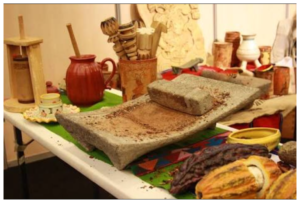 It is widely accepted that chocolate originated from ancient civilisations in Mesoamerica, namely the Mayans and Aztecs. The Aztecs ground cocoa beans into a coarse molten liquid, using a traditional stone grinder called a “metate”. The resultant molten cocoa was mixed with spices and sometime chilli, and consumed as a bitter beverage called xocoatl. When the Spanish discovered the Americas, they took this knowledge back to Europe and modified xocoatl to a sweet beverage by adding sugar.
It is widely accepted that chocolate originated from ancient civilisations in Mesoamerica, namely the Mayans and Aztecs. The Aztecs ground cocoa beans into a coarse molten liquid, using a traditional stone grinder called a “metate”. The resultant molten cocoa was mixed with spices and sometime chilli, and consumed as a bitter beverage called xocoatl. When the Spanish discovered the Americas, they took this knowledge back to Europe and modified xocoatl to a sweet beverage by adding sugar.
Today, the “metate” has given way to varied and advanced methods and tools for chocolate production, used by artisanal and commercial chocolate makers alike. However, one chocolate maker has bucked the trend by choosing to hold on to the traditional method of production, using only ground cocoa beans and sugar as base ingredients, thereby creating an unique old world chocolate experience in modern times.
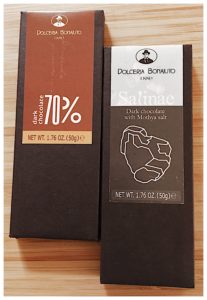 At first glance, the chocolate bars of Antico Dolceria Bonajuto, located in the little known town of Modica in Sicily, Italy, are undifferentiated – packaged in plain dark brown boxes with simple, coloured labels and the company logo. But, as I unwrap the chocolate, the difference becomes apparent. The chocolate looks grainy and uneven, like cocoa liquor that has been left to solidify. If I didn’t know better, I’d have thought that the chocolate is “off” or unfinished product.
At first glance, the chocolate bars of Antico Dolceria Bonajuto, located in the little known town of Modica in Sicily, Italy, are undifferentiated – packaged in plain dark brown boxes with simple, coloured labels and the company logo. But, as I unwrap the chocolate, the difference becomes apparent. The chocolate looks grainy and uneven, like cocoa liquor that has been left to solidify. If I didn’t know better, I’d have thought that the chocolate is “off” or unfinished product.
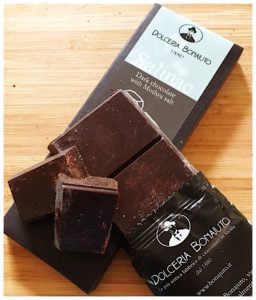 The aroma is toasty and earthy, like roasted coffee beans. These characteristics come across more prominently in the 80% bar with Mothya salt. As I break off a piece, I note the coarseness of the texture. I can see the fine cocoa nibs and granules of sugar, with the naked eye. I learn that this effect is the result of the chocolate being “cold worked” at a temperature below the melting point of sugar.
The aroma is toasty and earthy, like roasted coffee beans. These characteristics come across more prominently in the 80% bar with Mothya salt. As I break off a piece, I note the coarseness of the texture. I can see the fine cocoa nibs and granules of sugar, with the naked eye. I learn that this effect is the result of the chocolate being “cold worked” at a temperature below the melting point of sugar.
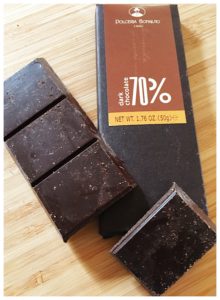 I put a piece in my mouth and let it melt. The grainy texture on my tongue feels unusual. As it slowly dissolves, the chocolate breaks up into smaller slumps. This is attributed to the absence of the conching process, which further refines the texture of chocolate to what we all associate today with finished chocolate.
I put a piece in my mouth and let it melt. The grainy texture on my tongue feels unusual. As it slowly dissolves, the chocolate breaks up into smaller slumps. This is attributed to the absence of the conching process, which further refines the texture of chocolate to what we all associate today with finished chocolate.
The 70% bar has fruity flavours and, because the sugar crystals are still intact, I get the alternating bitter sweet taste. The 80% bar is more earthy and bitter but, as it dissolves, the Mothya salt starts to bring out the sweetness of the chocolate, leaving a sweeter finish. The lingering after taste from both bars is that of mild bitterness, with toasty notes.
I’m still undecided if I like the taste and texture of ancient, unconched chocolate. But one thing is for certain – I thank the Spanish for their ingenuity in adding sugar to xocoatl many centuries ago, hence paving the way for the evolution of the chocolate that we all love and enjoy today?
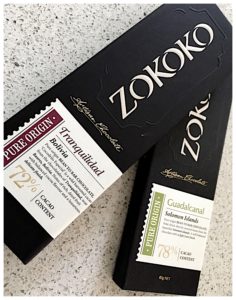 I learn that the Tranquilidad is made from very rare criollo cacao beans found only in the rainforests of the Beni, in the north eastern region of Bolivia. These beans, also referred to as Beniano or Cacao Silverstri, are characterised by its distinctive small pods and significantly smaller size of the beans. The Guadalcanal, on the other hand, is derived from trinitario cacao beans grown in the unique volcanic soil of the Solomon Islands.
I learn that the Tranquilidad is made from very rare criollo cacao beans found only in the rainforests of the Beni, in the north eastern region of Bolivia. These beans, also referred to as Beniano or Cacao Silverstri, are characterised by its distinctive small pods and significantly smaller size of the beans. The Guadalcanal, on the other hand, is derived from trinitario cacao beans grown in the unique volcanic soil of the Solomon Islands.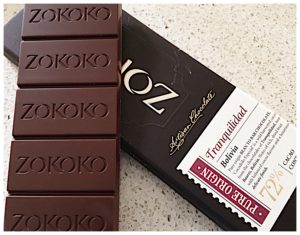 he aroma of the Tranquilidad is pleasant and somewhat earthy, like a cross between mild mushrooms and prunes. As it melts in my mouth, the texture is smooth and even. I taste berries initially, slightly tart and mildly acidic on my tongue. This gives way slowly to a milder nutty flavour, like that of roasted cashew nuts.
he aroma of the Tranquilidad is pleasant and somewhat earthy, like a cross between mild mushrooms and prunes. As it melts in my mouth, the texture is smooth and even. I taste berries initially, slightly tart and mildly acidic on my tongue. This gives way slowly to a milder nutty flavour, like that of roasted cashew nuts.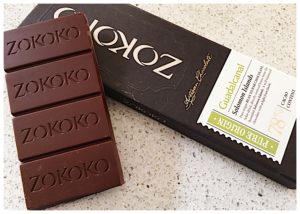 The Guadalcanal is distinctly different, with a slight woody nose and hints of liquorice. As it melts on my tongue, robust and toasty flavours are released, almost charcoal-like. It’s as if I can taste the volcanic soil from which the cocoa trees have been grown in. There’s a tinge of bitterness and acidity on my tongue. The punchy flavours are replaced by a gentler fleeting finish of lemon peel, which leaves a refreshing after taste on my tongue and palate.
The Guadalcanal is distinctly different, with a slight woody nose and hints of liquorice. As it melts on my tongue, robust and toasty flavours are released, almost charcoal-like. It’s as if I can taste the volcanic soil from which the cocoa trees have been grown in. There’s a tinge of bitterness and acidity on my tongue. The punchy flavours are replaced by a gentler fleeting finish of lemon peel, which leaves a refreshing after taste on my tongue and palate.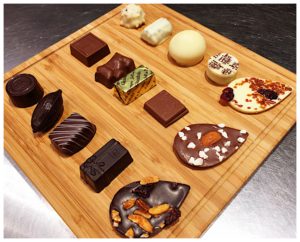 As I arrive at Jeff’s, Audrey, whom I’d been corresponding with recently, and the lovely shop assistant from my previous visit, Esther, are there to greet me. Of course, the heavenly sight and aroma of chocolates are inviting too. Audrey leads me to the rear of the shop where a platter of Jeff’s best has been beautifully laid out just for me!
As I arrive at Jeff’s, Audrey, whom I’d been corresponding with recently, and the lovely shop assistant from my previous visit, Esther, are there to greet me. Of course, the heavenly sight and aroma of chocolates are inviting too. Audrey leads me to the rear of the shop where a platter of Jeff’s best has been beautifully laid out just for me!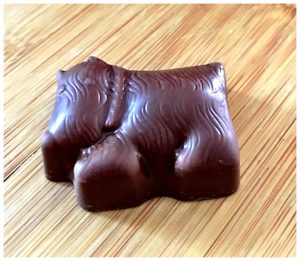 After initial introductions and some exchanges in my very limited (petit peu) French, we dive straight into the chocolates. Several on the platter are familiar – I’ve purchased and tasted them during my first visit, so I hone in on the lesser known. Audrey points to the milk chocolate Scottish Terrier-shaped piece (named Warren). “It’s different” she says, when I inform her that I’d previously tried the dark chocolate version. I take my first bite and affirm that she’s right. It’s a textural teaser. The crunchiness of the hazelnut praline, complemented by the caramelised and toasted sesame seeds, hits you first, followed by the smoothness of the milk chocolate. It’s sweet, nutty and slightly buttery all in the one mouthful.
After initial introductions and some exchanges in my very limited (petit peu) French, we dive straight into the chocolates. Several on the platter are familiar – I’ve purchased and tasted them during my first visit, so I hone in on the lesser known. Audrey points to the milk chocolate Scottish Terrier-shaped piece (named Warren). “It’s different” she says, when I inform her that I’d previously tried the dark chocolate version. I take my first bite and affirm that she’s right. It’s a textural teaser. The crunchiness of the hazelnut praline, complemented by the caramelised and toasted sesame seeds, hits you first, followed by the smoothness of the milk chocolate. It’s sweet, nutty and slightly buttery all in the one mouthful.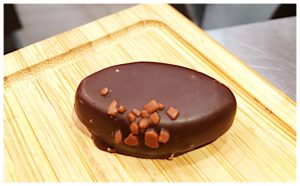 On the theme of atypical Belgian, Audrey brings me the Espelette. “You may like this one” she tells me. As I sink my teeth through the milk chocolate coating, I am met with a well balanced caramel ganache. But it’s as the caramel ganache dissolves that the Espelette surprise is revealed. There are hints of spicyness; not overpowering, just enough to let you know that it’s there. I could have done with a bit more spice but I understand – they need to cater to extreme levels of tolerance. Esther tells me that the spicyness comes from peppers or chillies from Espelette, a quaint village dedicated to chillies in the French Basque Country, south of the wine region of Bordeaux.
On the theme of atypical Belgian, Audrey brings me the Espelette. “You may like this one” she tells me. As I sink my teeth through the milk chocolate coating, I am met with a well balanced caramel ganache. But it’s as the caramel ganache dissolves that the Espelette surprise is revealed. There are hints of spicyness; not overpowering, just enough to let you know that it’s there. I could have done with a bit more spice but I understand – they need to cater to extreme levels of tolerance. Esther tells me that the spicyness comes from peppers or chillies from Espelette, a quaint village dedicated to chillies in the French Basque Country, south of the wine region of Bordeaux.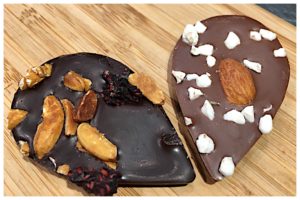 Next on the “to try” list are one each of Audrey and Esther’s favourite Juliette (Jeff’s version of the mendiant). The dark chocolate Juliette with caramelised slivers of almonds and dried berries is, in my opinion, a perfect post-dinner treat. The dark chocolate is the supporting act to the main stars, the caramelised almonds and berries. The milk chocolate Juliette is a play on textures, with a crunchy whole almond in the centre and chewy bits of nougat. I’m not initially wowed by it until Esther offers me another piece with more aniseeds. The aniseeds add a whole new dimension to the taste experience and somehow, to me, keeps the overall sweetness level of the Juliette in check. Aniseed and milk chocolate – nice! And once again, atypical Belgian.
Next on the “to try” list are one each of Audrey and Esther’s favourite Juliette (Jeff’s version of the mendiant). The dark chocolate Juliette with caramelised slivers of almonds and dried berries is, in my opinion, a perfect post-dinner treat. The dark chocolate is the supporting act to the main stars, the caramelised almonds and berries. The milk chocolate Juliette is a play on textures, with a crunchy whole almond in the centre and chewy bits of nougat. I’m not initially wowed by it until Esther offers me another piece with more aniseeds. The aniseeds add a whole new dimension to the taste experience and somehow, to me, keeps the overall sweetness level of the Juliette in check. Aniseed and milk chocolate – nice! And once again, atypical Belgian.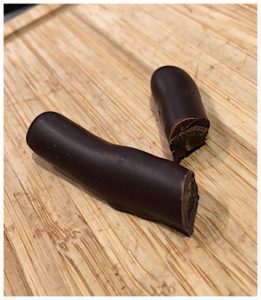 Audrey tells me that I need to try the Orangette. It’s apparently a traditional Christmas treat in France. My initial reaction is lukewarm as I’ve had many a chocolate-coated candied fruit in the past and found them too sweet. However, I oblige and slice a piece off the baton-shaped treat. Think a cold serve of orange juice on a warm summer’s day. The candied orange is refreshing and sweet, but not overly sweet like candied or glacé fruit. And it pairs very well with the dark chocolate. Plus the proportion of fruit and chocolate is just right. A great palate cleanser, I reckon.
Audrey tells me that I need to try the Orangette. It’s apparently a traditional Christmas treat in France. My initial reaction is lukewarm as I’ve had many a chocolate-coated candied fruit in the past and found them too sweet. However, I oblige and slice a piece off the baton-shaped treat. Think a cold serve of orange juice on a warm summer’s day. The candied orange is refreshing and sweet, but not overly sweet like candied or glacé fruit. And it pairs very well with the dark chocolate. Plus the proportion of fruit and chocolate is just right. A great palate cleanser, I reckon.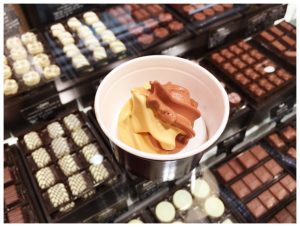 I turn my attention to Jeff’s ice cream, to which Audrey asks “Have you had them before?”. I admit that I have not, so Audrey enthusiastically leads me to the ice cream section. Esther recommends that I give the salted caramel and chocolate ice cream a go. I must say, I’ve tried variants the world over and this one actually rates quite highly on my list. Each flavour is distinct and well controlled so that it does not overpower the other. And the sweetness level is spot on, unlike many other commercial and store-bought offerings that have yet to strike the correct balance. A sure hit for the coming summer months. Just wished that I could have purchased some to take home.
I turn my attention to Jeff’s ice cream, to which Audrey asks “Have you had them before?”. I admit that I have not, so Audrey enthusiastically leads me to the ice cream section. Esther recommends that I give the salted caramel and chocolate ice cream a go. I must say, I’ve tried variants the world over and this one actually rates quite highly on my list. Each flavour is distinct and well controlled so that it does not overpower the other. And the sweetness level is spot on, unlike many other commercial and store-bought offerings that have yet to strike the correct balance. A sure hit for the coming summer months. Just wished that I could have purchased some to take home.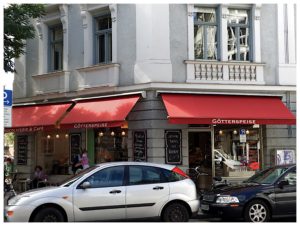 I have Printi, the lovely owner of Goetterspiese Chocolaterie in Munich, to thank for this recent discovery. I was driven by curiosity, above all else, when Priti suggested that I give these chocolates a go.
I have Printi, the lovely owner of Goetterspiese Chocolaterie in Munich, to thank for this recent discovery. I was driven by curiosity, above all else, when Priti suggested that I give these chocolates a go. The filled pralines and ganaches look distinctly Australian, primarily because of the beautiful Aboriginal art inspired motifs on each piece. The finish is also rustic and somewhat laid-back, quite like Aussie culture. Definitely not your mainstream glossy and dainty Belgian praline or truffle.
The filled pralines and ganaches look distinctly Australian, primarily because of the beautiful Aboriginal art inspired motifs on each piece. The finish is also rustic and somewhat laid-back, quite like Aussie culture. Definitely not your mainstream glossy and dainty Belgian praline or truffle.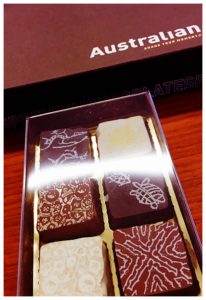 The generous, larger than bite-sized chocolates come in attractive pre-packaged boxes of 4s, 6s, 9s, 16s, 25s and more. However, one can also choose from the display of available varieties. I self-select a box of 6s, of mainly dark chocolate pralines and ganaches, based on Priti’s recommendation.
The generous, larger than bite-sized chocolates come in attractive pre-packaged boxes of 4s, 6s, 9s, 16s, 25s and more. However, one can also choose from the display of available varieties. I self-select a box of 6s, of mainly dark chocolate pralines and ganaches, based on Priti’s recommendation.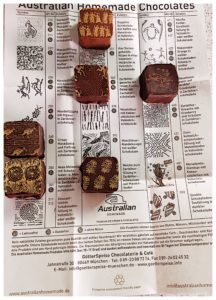 The double chocolate with coffee and hazelnut, in milk chocolate, is also worthy of a mention. It’s a triple layer of praline, thick coffee ganache and hazelnut marzipan, enrobed in milk chocolate. The coffee flavour is surprisingly controlled, allowing the attributes of the praline and marzipan to shine through. In fact, I would go as far as to say that the flavours are complimentary, although unconventional.
The double chocolate with coffee and hazelnut, in milk chocolate, is also worthy of a mention. It’s a triple layer of praline, thick coffee ganache and hazelnut marzipan, enrobed in milk chocolate. The coffee flavour is surprisingly controlled, allowing the attributes of the praline and marzipan to shine through. In fact, I would go as far as to say that the flavours are complimentary, although unconventional.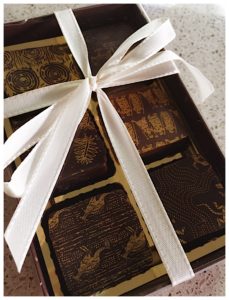 Priti tells me that
Priti tells me that 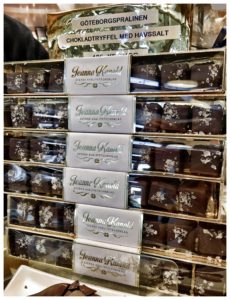 When in Gothenburg, do seek out
When in Gothenburg, do seek out 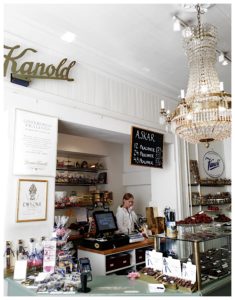
 The strong and savoury adelost, coupled with the mildly sweet and ever so slight bitterness of the dark chocolate, is a match made in heaven.
The strong and savoury adelost, coupled with the mildly sweet and ever so slight bitterness of the dark chocolate, is a match made in heaven.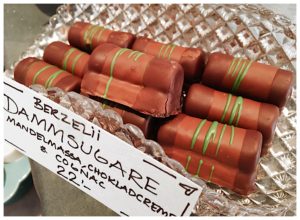 Translated into English, it simply means vacuum cleaner. However, to the locals, the word dammsugare (also known as the punschrulle or punsch roll) is fondly associated with a quintessential Swedish treat.
Translated into English, it simply means vacuum cleaner. However, to the locals, the word dammsugare (also known as the punschrulle or punsch roll) is fondly associated with a quintessential Swedish treat.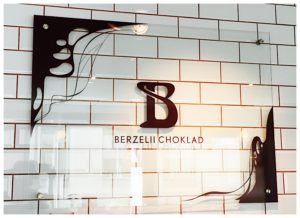 At
At 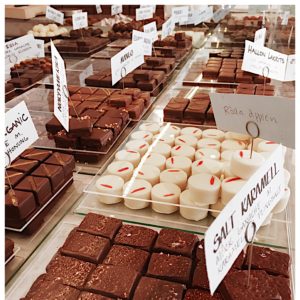 These are small and tart red berries, native to and found in abundance in Sweden and other Nordic countries. For a Swedish experience, try the lingonberry in dark chocolate ganache at
These are small and tart red berries, native to and found in abundance in Sweden and other Nordic countries. For a Swedish experience, try the lingonberry in dark chocolate ganache at 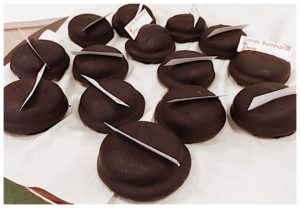 The chocolate biscuit, more popularly known as the Sarah Bernhardt, is yet another favourite treat that I’ve discovered. Named after the famous French actress of the 19th and early 20th century, Sarah apparently fell head over heels for this sweet treat while on a visit to Denmark. It was subsequently named after her. The Swedish too have developed a fondness for it and named it their chokladbiskvi (chocolate biscuit in Swedish).
The chocolate biscuit, more popularly known as the Sarah Bernhardt, is yet another favourite treat that I’ve discovered. Named after the famous French actress of the 19th and early 20th century, Sarah apparently fell head over heels for this sweet treat while on a visit to Denmark. It was subsequently named after her. The Swedish too have developed a fondness for it and named it their chokladbiskvi (chocolate biscuit in Swedish).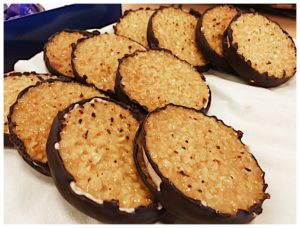 Daim is to the Swedish (and Nordics in general) what Hershey’s is to the Americans. You can find it at any supermarket and convenience store, at every train station and even at the airport. It’s crunchy almond brittle, coated in milk chocolate.
Daim is to the Swedish (and Nordics in general) what Hershey’s is to the Americans. You can find it at any supermarket and convenience store, at every train station and even at the airport. It’s crunchy almond brittle, coated in milk chocolate.